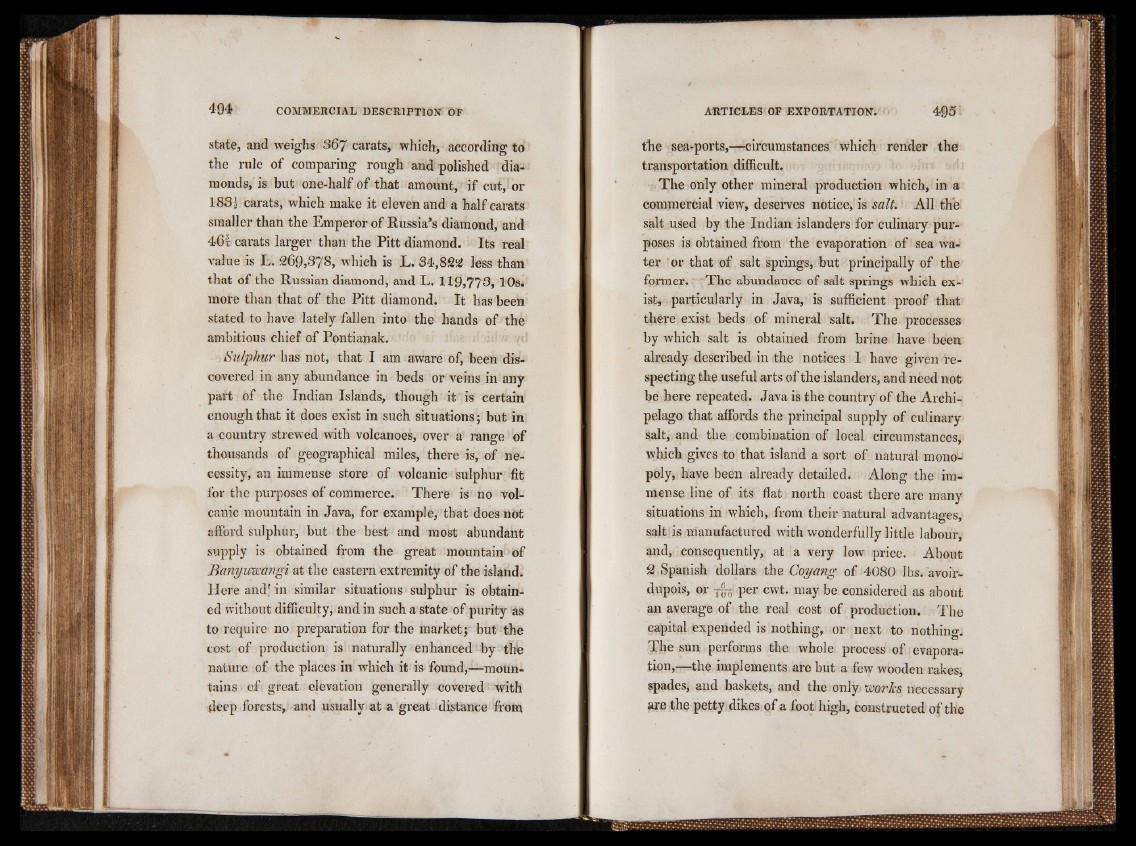
state, and weighs 367 carats, which, according to
the rule of comparing rough and polished diamonds,
is but one-half of that amount, if cut, or
1832 carats, which make it eleven and a half carats
smaller than the Emperor of Russia’s diamond, and
461 carats larger than the Pitt diamond. Its real
value is L. 269,378, which is L. 34,822 less than
that of the Russian diamond, and L. 119,773,10s.
more than that of the Pitt diamond. It has been
stated to have lately fallen into the hands of the
ambitious chief of Pontianak.
Sulphur has not, that I am aware of, been discovered
in any abundance in beds or veins in any
part of the Indian Islands, though it is certain
enough that it does exist in such situations; but in
a country strewed with volcanoes, over a range of
thousands of geographical miles, there is, of necessity,
an immense store of volcanic sulphur fit
for the purposes of commerce. There is no volcanic
mountain in Java, for example, that does not
afford sulphur, but the best and most abundant
supply is obtained from the great mountain of
Banywwangi at the eastern extremity of the island.
Here and' in similar situations sulphur is obtained
without difficulty, and in such a state of purity as
to require no preparation for the market;' but the
cost of production is naturally enhanced by the
nature of the places in which it is found,-—mountains
of great elevation generally covered with
deep forests, and usually at a great distance from
the sea-ports,— circumstances which render the
transportation difficult.
The only other mineral production which, in a
commercial view, deserves notice, is salt. All the
salt used by the Indian islanders for culinary purposes
is obtained from the evaporation of sea water
or that of salt springs, but principally of the
former. The abundance of salt springs which exist,
particularly in Java, is sufficient proof that
there exist beds of mineral salt. The processes
by which salt is obtained from brine have been
already described in the notices I have given respecting
the useful arts of the islanders, and need not
be here repeated. Java is the country of the Archipelago
that affords the principal supply of culinary
salt, and the combination of local circumstances,
which gives to that island a sort of natural monopoly,
have been already detailed. Along the immense
line of its flat north coast there are many
situations in which, from their natural advantages, O 7 salt is manufactured with wonderfully little labour,
and, consequently, at a very low price. About
2 Spanish dollars the Coyang of 4080 lbs. avoirdupois,
or i | per cwt. may be considered as about
an average of the real cost of production. The
capital expended is nothing, or next to nothing.
The sun performs the whole process of evaporation,—
the implements are but a few wooden rakes,
spades, and baskets, and the only wovlcs necessary
are the petty dikes of a foot high, constructed of the